This complete guide breaks down how to apply to American university as an international student into clear, manageable steps. From researching programs and preparing your documents to acing visa interviews and adjusting to life on campus, you’ll find everything you need to make your dream of studying in the U.S. a reality.
Why Study in the U.S.?
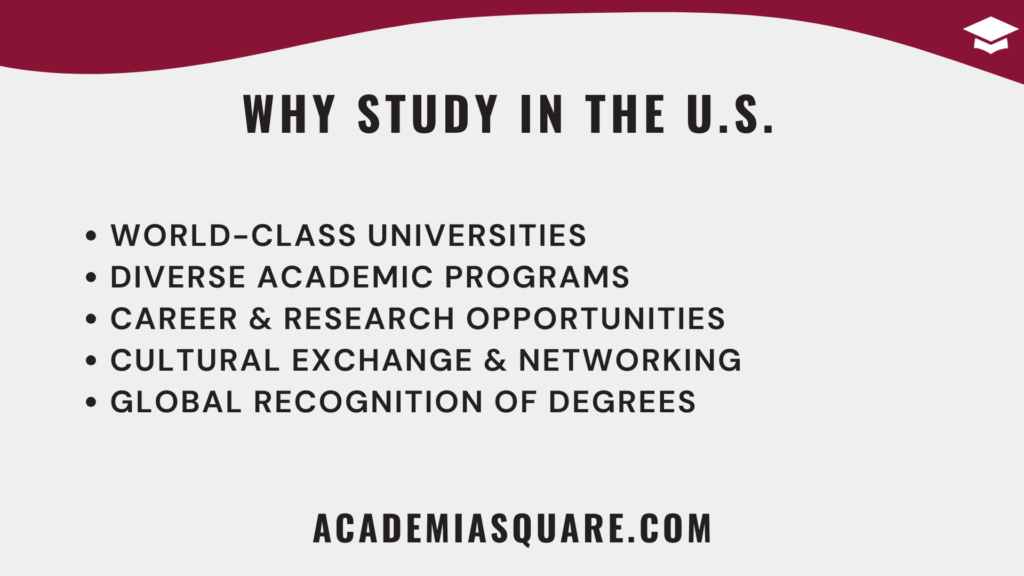
Each year, more than one million international students choose to study in the United States — and for good reason. The U.S. remains one of the most sought-after destinations for higher education thanks to its academic excellence, diverse cultural landscape, and career development opportunities. If you’re wondering how to apply to American university as an international student, the first step is understanding why it’s worth the effort.
American universities consistently rank among the top in the world, offering cutting-edge research, flexible learning options, and highly regarded degree programs. But beyond prestige, these institutions provide an educational environment built on critical thinking, creativity, and cross-disciplinary learning — qualities that are increasingly valued in today’s global workforce.
Top Reasons to Study in the United States
There are a variety of benefits to pursuing higher education in the U.S. Here are some of the key factors that attract international students from over 190 countries:
- Academic Excellence: U.S. institutions dominate international rankings and offer globally recognized degrees.
- Wide Range of Programs: From liberal arts colleges to STEM-focused universities, you can tailor your education to match your interests and goals.
- Research and Innovation: Access to advanced facilities, funding, and academic mentorship allows students to participate in groundbreaking research.
- Campus Diversity: Multicultural campuses foster inclusion, networking, and lifelong friendships across cultures.
- Career Advancement: U.S. degrees open doors worldwide and often include internship or Optional Practical Training (OPT) opportunities.
How to Apply to American University as an International Student: Laying the Groundwork
Before you begin your application journey, it’s essential to define why studying in the U.S. aligns with your personal and academic goals. Many students are driven by the desire to access better educational resources, learn from global faculty, or improve future job prospects. Knowing your “why” helps you stay focused — especially when navigating a complex admissions process.
Planning ahead is critical. Most U.S. universities require applications to be submitted 8–12 months in advance of the intended start date. That means you should start researching schools, testing requirements, and funding options at least a year before you hope to enroll.
How to Get Better Grades and Prepare for U.S. Academics
The U.S. academic system rewards active participation, critical analysis, and independent thinking — which may differ from what you’re used to. To succeed, international students often need to adjust their study habits and expectations. Here are a few research-backed strategies to help you thrive:
- Use proven learning techniques such as spaced repetition, active recall, and the SQ3R method to process and retain information more effectively.
- Improve your academic English by reading scholarly texts, writing summaries, and practicing with tools like Grammarly or Quillbot.
- Participate in study groups and engage in classroom discussions to sharpen your communication skills and understanding of course material.
U.S. universities often provide academic support centers, writing labs, and tutoring services — take full advantage of them. Building a strong academic foundation early on not only improves your GPA but also strengthens your confidence in applying to competitive programs.
The Global Edge: Why U.S. Degrees Matter
According to data from the Institute of International Education (IIE), over 90% of international students report high satisfaction with their academic experience in the U.S. Employers around the world recognize the value of a U.S. education — especially for roles in tech, medicine, business, and research.
By choosing to study in the U.S., you’re not just getting a degree — you’re joining a network of global thinkers and change-makers. And as you explore how to apply to American university as an international student, keep this long-term perspective in mind: you’re investing in a future that’s both academically fulfilling and professionally transformative.
Understanding the U.S. Higher Education System
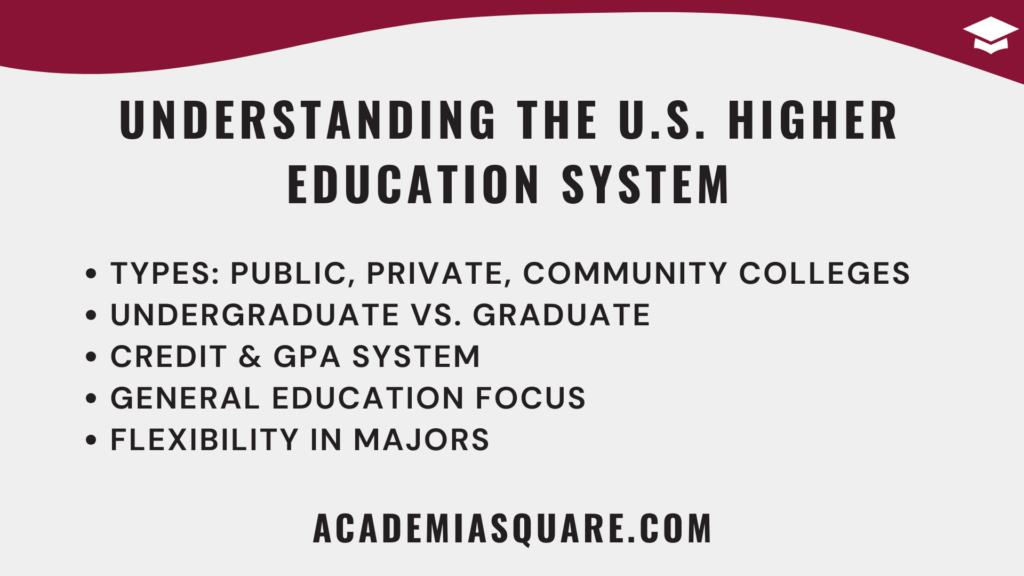
Before diving into how to apply to American university as an international student, you need to fully understand the structure and philosophy behind U.S. higher education. The American system is known for its flexibility, variety, and strong emphasis on liberal arts and interdisciplinary study — all of which might differ significantly from what you’re used to.
Students have access to a wide spectrum of institutions, ranging from small liberal arts colleges to large research universities, each offering unique academic and cultural experiences. Recognizing these distinctions can help you identify the right kind of environment for your goals and learning style.
Types of U.S. Institutions
Here are the main categories of institutions international students can apply to:
- Community Colleges: These offer 2-year associate degrees and are often more affordable. Students can later transfer to a 4-year university.
- Liberal Arts Colleges: Small to medium-sized institutions focused on undergraduate education with an emphasis on humanities and sciences.
- Public Universities: State-funded institutions offering a wide range of undergraduate and graduate programs, often with lower tuition for residents.
- Private Universities: Privately funded schools known for prestige, smaller class sizes, and strong alumni networks.
Each of these offers different advantages in terms of size, academic approach, and cost. Your choice should depend on your field of study, budget, and long-term aspirations.
Undergraduate vs. Graduate Studies
U.S. universities divide their programs into two main levels:
- Undergraduate: Includes Associate (2-year) and Bachelor’s (4-year) degrees. Students explore general education before specializing.
- Graduate: Includes Master’s and Doctoral degrees. Admission often requires a bachelor’s degree, strong academic record, and research interests.
One unique element is the general education component, where undergraduate students study a wide range of subjects before declaring a major. This approach encourages holistic thinking and adaptability — skills crucial for a rapidly changing world.
Credit System and GPA
The American education system uses a credit hour system. A bachelor’s degree usually requires 120–130 credit hours. Students must maintain a solid GPA (Grade Point Average), typically on a 4.0 scale, to graduate and remain in good standing — especially important for visa status and scholarship eligibility.
If you’re asking yourself how to succeed academically as an international student, understanding this system is crucial. You’ll be expected to manage your own course load and schedule, often choosing electives that align with your career goals.
Knowing these academic mechanics not only prepares you for life in the classroom but also helps you frame a more informed and competitive application later on.
How to Apply to American University as an International Student: An Overview
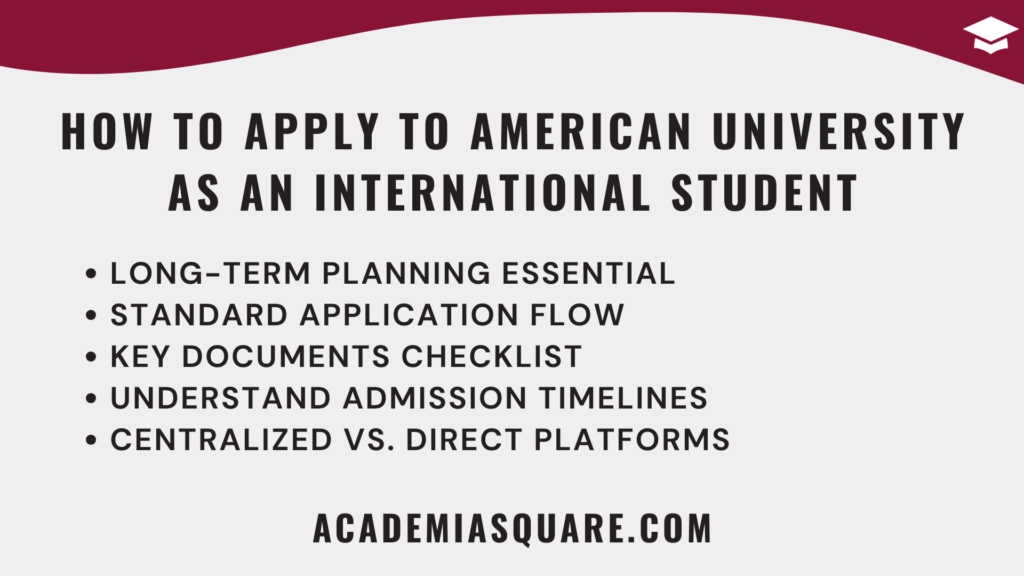
Once you understand the structure of U.S. higher education, it’s time to look at the big picture of the application process for international students. This journey involves more than just filling out forms — it’s about presenting your story, your achievements, and your goals in a clear and compelling way.
How the Application Process Works
Applying to a U.S. university typically involves several steps. While each institution has its own specific requirements, the general process includes:
- Researching and selecting schools that match your goals and budget.
- Registering for required exams like the TOEFL, IELTS, SAT, ACT, GRE, or GMAT.
- Preparing documents such as academic transcripts, recommendation letters, a personal statement, and financial records.
- Submitting online applications via each university’s portal or through platforms like the Common App.
- Attending interviews if required (usually for graduate programs or elite institutions).
- Applying for student visas once an acceptance letter is received (detailed in Chapter 8).
Important Application Timelines
Most universities have application deadlines between November and January for fall intake (August/September start). Some institutions also offer spring (January) or summer (May) intakes. Always verify deadlines directly on the university’s admissions page.
Here’s a general timeline to follow:
- 12 months before: Research schools and prep for standardized tests.
- 9–10 months before: Take tests, gather documents, and write personal essays.
- 6–8 months before: Submit applications and track your status.
- 3–4 months before: Apply for your F-1 visa and arrange housing/travel.
Common Mistakes When Applying to U.S. Universities
Students often underestimate the time and precision required to complete the application process. Here are common pitfalls to avoid:
- Applying to too few schools or only high-ranked ones without safety options.
- Ignoring each school’s unique essay or financial documentation requirements.
- Missing deadlines or submitting incomplete applications.
Take a structured, methodical approach. Use tools like Trello or Notion to track application tasks, deadlines, and submissions. Keeping everything organized ensures a smoother experience and reduces the risk of missed opportunities.
Understanding how to apply to American university as an international student starts with this high-level overview. In the next chapters, we’ll explore each component of this process — from selecting schools to crafting essays and preparing for visa interviews — in detail.
Researching and Selecting the Right Universities
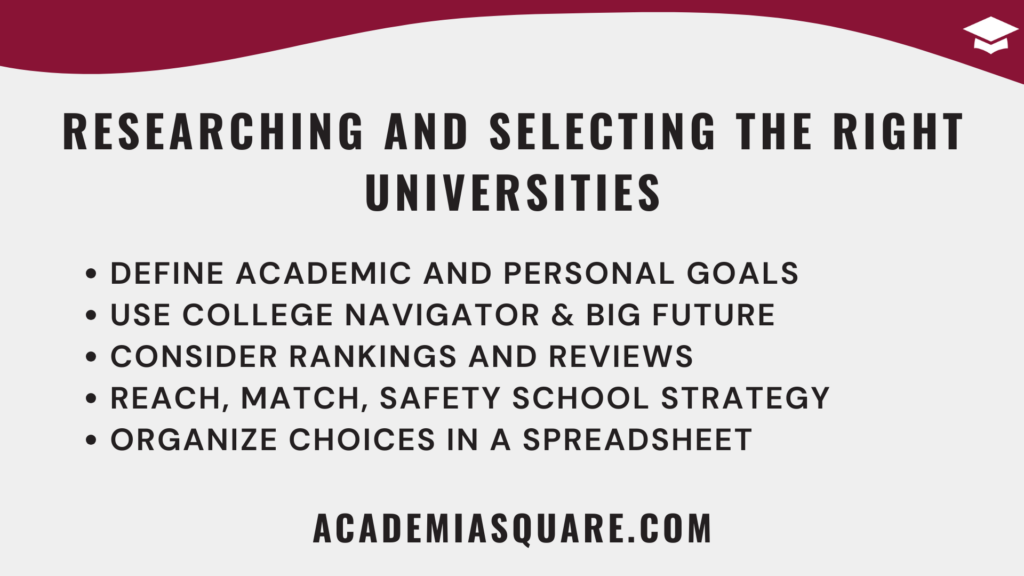
One of the most strategic steps in how to apply to American university as an international student is choosing the right institutions to target. The U.S. has over 4,000 accredited universities and colleges — which means the options can be overwhelming without a clear process in place.
Your success and satisfaction as an international student will depend greatly on your university match. That includes academic fit, financial feasibility, support services, cultural environment, and location. This chapter offers a research-backed approach to help you identify the best options for your personal and academic growth.
Define Your Goals and Priorities
Before diving into rankings or campus photos, reflect on what matters most to you. Consider:
- Academic Focus: Are you looking for strong engineering programs? Business schools? Liberal arts education?
- Budget: What is your maximum tuition and living expense budget? Will you apply for scholarships?
- Location Preferences: Urban or rural? East Coast, West Coast, or Midwest? Weather and proximity to airports may also play a role.
- Campus Culture: Do you prefer large universities with a vibrant student life or smaller colleges with more individualized attention?
- Career Services: Check the availability of internships, Optional Practical Training (OPT), and post-graduation employment support.
Rankings can be helpful, but they shouldn’t be your sole guide. U.S. News, QS World Rankings, and Times Higher Ed are good starting points, but always combine them with student reviews, job placement rates, and faculty research output.
Use Official Resources to Compare Schools
These tools can make your search more structured:
- College Navigator by the U.S. Department of Education: Filter universities by location, tuition, size, and programs offered.
- Big Future by College Board: Helps you explore colleges based on preferences and compare side-by-side.
- EducationUSA: A global resource network of the U.S. Department of State that offers guidance specific to international applicants.
Shortlist and Organize Your University Targets
Divide your target schools into three categories:
- Reach Schools: Highly competitive institutions where admission is possible but uncertain.
- Match Schools: Schools where your academic profile aligns well with the average admitted student.
- Safety Schools: Institutions where you exceed the admission requirements and are more likely to get accepted.
A balanced list typically includes 2–3 schools in each category. Use spreadsheets or tools like Notion to track deadlines, application portals, test requirements, and contact information.
Remember, the quality of your education isn’t determined solely by the university name — it’s about how well the school fits your goals and supports your growth. The research you do here lays the foundation for a smoother application and ultimately a more fulfilling college experience.
Standardized Tests and English Proficiency Requirements
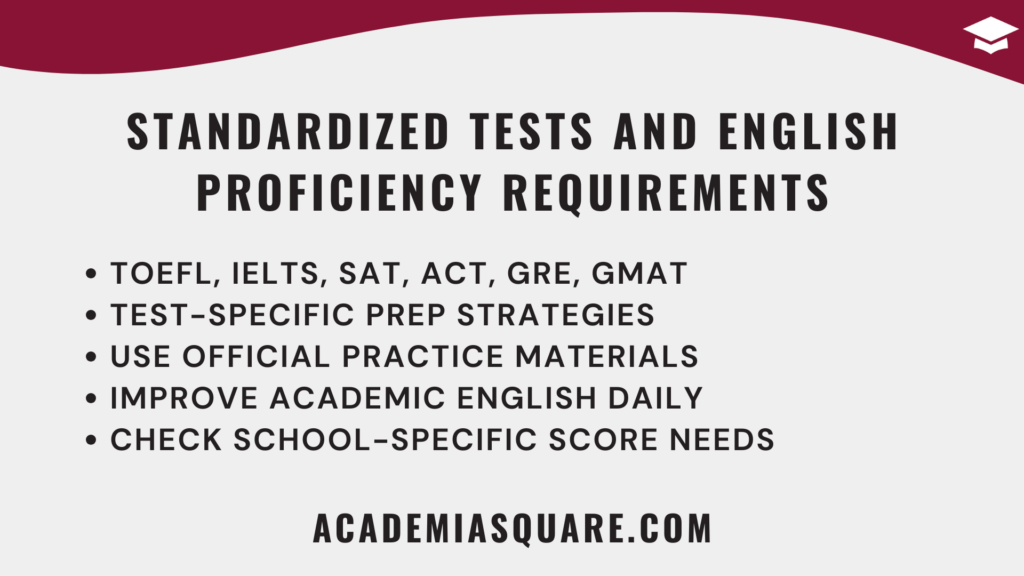
A critical step in how to apply to American university as an international student is preparing for and completing the necessary standardized exams. These tests help universities assess your academic readiness and language proficiency — especially since your previous education may follow different standards.
Understanding the Test Landscape
Most international applicants need to take a combination of these tests, depending on the level and field of study:
- SAT or ACT: Required by many undergraduate programs. SAT focuses on math, reading, and writing; ACT adds a science section.
- TOEFL or IELTS: Required by almost all universities to assess English proficiency if you’re from a non-English-speaking country.
- GRE or GMAT: Required for many graduate programs. GRE is more common across disciplines; GMAT is specific to business schools.
- Duolingo English Test: An increasingly accepted, affordable alternative to TOEFL/IELTS with quick turnaround.
Each institution will have its own minimum score requirements, so always check the specific admissions page. Don’t assume one test fits all.
How to Prepare Effectively for Standardized Tests
Strong test scores can significantly strengthen your application and even qualify you for merit-based scholarships. Here are proven strategies to maximize your performance:
- Use official practice tests from College Board, ETS, or the testing company’s website.
- Study over time using spaced repetition and active recall — methods shown in cognitive psychology to improve long-term retention.
- Enroll in affordable online prep platforms like Khan Academy, Magoosh, or PrepScholar.
- Join peer study groups or online forums like Reddit’s r/SAT or r/GRE for tips and motivation.
English Proficiency: Beyond Just Passing the Test
While it’s crucial to meet the minimum score, true success in a U.S. academic environment requires solid language skills. You’ll need to write research papers, participate in class discussions, and navigate day-to-day conversations with professors and peers.
To improve your academic English:
- Read English newspapers, journals, and blogs daily to expand vocabulary and comprehension.
- Watch U.S. academic lectures on YouTube or Coursera to tune your ear to university-level English.
- Practice speaking with native or fluent speakers via platforms like iTalki or Tandem.
Taking the right tests — and scoring well — proves your readiness. But it also boosts your confidence. Don’t view them as mere gatekeeping tools; think of them as part of your training to thrive in a new academic culture.
These exams will reappear in later steps, from application requirements to scholarship decisions and even visa interviews. Mastering them early gives you a significant advantage.
Preparing Application Materials
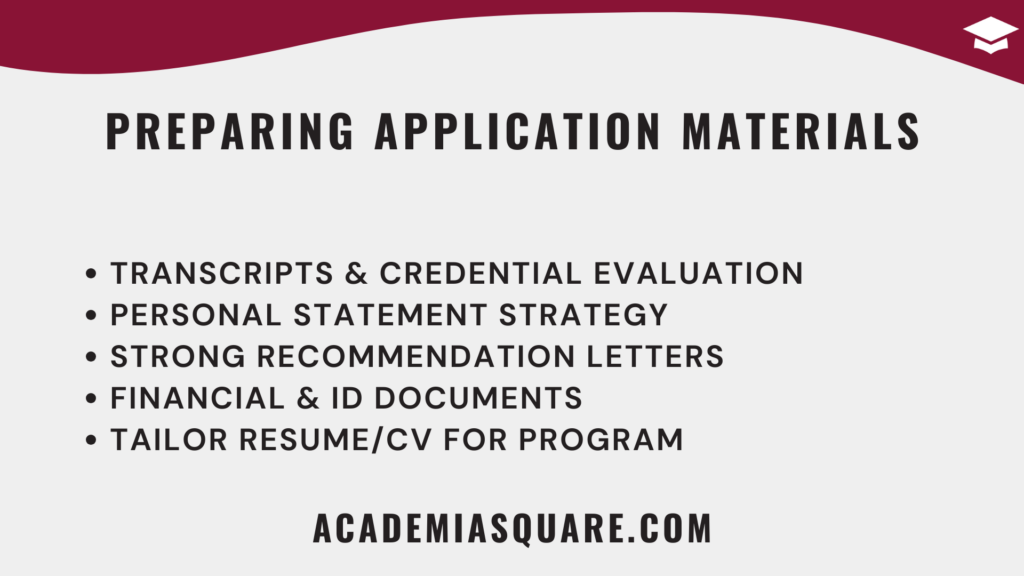
Now that you’ve shortlisted your universities and started preparing for exams, it’s time to gather the documents that will tell your academic and personal story. This stage is one of the most essential in how to apply to American university as an international student. Your application materials form the first impression you make on an admissions officer — they must be clear, honest, and compelling.
In most cases, universities will require a combination of academic records, personal essays, letters of recommendation, financial documentation, and test scores. Depending on the institution, specific requirements may vary, so always double-check each university’s admissions webpage.
Academic Transcripts and Credential Evaluation
Your academic transcripts are one of the most important components of your application. U.S. universities want to see your academic history in a format they can understand. This often means submitting:
- Official transcripts from your secondary school (for undergraduate applicants) or undergraduate degree (for graduate applicants).
- A certified English translation of your documents if they are in another language.
- Credential evaluation from services like WES, ECE, or SpanTran, depending on the university’s requirement.
Start this process early — credential evaluations can take several weeks. Also, ensure your transcripts include grading scales and rank (if available), which help admissions staff contextualize your achievements.
Personal Statement or Statement of Purpose (SOP)
This essay is your chance to speak directly to the admissions committee. It’s not just about listing accomplishments, but about telling your story — why you want to study in the U.S., what drives you, and how their program aligns with your goals.
Research-backed writing tips suggest that the most effective essays:
- Open with a personal anecdote or experience that shaped your academic journey.
- Clearly explain your goals, especially how the program fits into your long-term plans.
- Demonstrate your understanding of the university’s values, curriculum, or faculty.
- Are concise, focused, and free of grammatical errors. Use tools like Grammarly or Hemingway to polish your writing.
Some universities may provide specific prompts, so tailor your essay accordingly. Avoid generic statements — authenticity is key.
Letters of Recommendation
Most universities require 2–3 recommendation letters from teachers, professors, or supervisors who know you well. Their role is to validate your achievements, character, and potential.
To ensure strong letters:
- Choose recommenders who can speak to your academic or professional abilities — not just your personality.
- Provide them with your resume, transcripts, and a brief description of your goals.
- Give them at least 3–4 weeks of advance notice. Follow up politely if needed.
Other Required Documents
- Proof of finances: Bank statements or sponsor letters showing you can fund your studies (required later for visa but often part of the application).
- Resume/CV: Required for many graduate programs. Highlight academic background, research, internships, and extracurriculars.
- Portfolio: For art, architecture, or design programs, universities may ask for a digital portfolio of your work.
Carefully organizing these materials and preparing them ahead of time can make the difference between a rushed application and one that stands out. Think of this as your academic brand — the way you present yourself to institutions you hope to join.
Navigating the Application Process
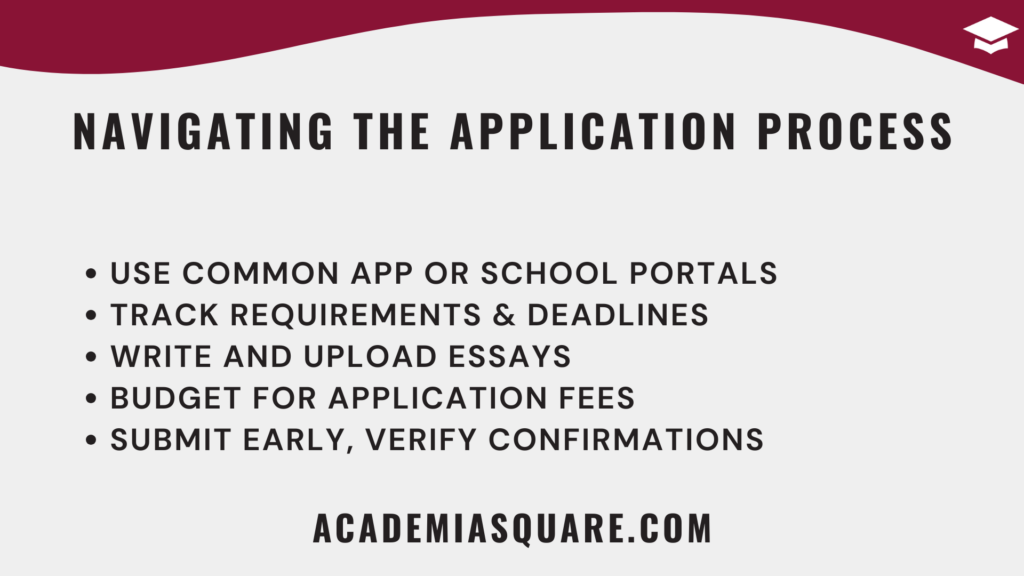
With all your materials in place, you’re ready to apply. This is where the entire strategy of how to apply to American university as an international student comes together. The actual application process can differ based on whether you’re applying to undergraduate or graduate programs, but many principles remain the same.
In this chapter, we walk through the mechanics: online application portals, deadlines, submission steps, and helpful tools to stay organized.
Choosing the Right Application Platform
Most undergraduate applications are submitted through centralized platforms:
- Common App: Accepted by 1,000+ colleges. Streamlines the process but may still require supplemental essays for each school.
- Coalition App: Used by a smaller number of schools, focused on access and affordability.
- University Portals: Some universities (especially public institutions) use their own systems.
For graduate programs, you’ll usually apply directly through the university’s application portal. Many business schools also use the GMAC portal for MBA programs.
Key Sections of the Application
Most applications require you to fill out sections such as:
- Personal details: Passport name, date of birth, citizenship, etc.
- Educational background: Schools attended, GPA, and class rank.
- Test scores: TOEFL, IELTS, SAT, ACT, GRE, etc. Some platforms allow self-reporting before official scores arrive.
- Activities: Clubs, sports, community service, leadership roles — don’t skip this!
- Essays and supplemental questions: Always double-check word counts and prompts.
Have all documents in PDF format and check file size limits. Universities may reject files that are unreadable or incorrectly labeled.
Meeting Deadlines and Staying Organized
Deadlines are strict — U.S. universities will not consider late applications unless you have extraordinary circumstances. Here’s how to stay on track:
- Create a shared calendar (Google Calendar or Notion) with application deadlines and reminder dates.
- Use a spreadsheet to track required materials for each school, submission status, and confirmation emails.
- Start early — aim to submit at least 1–2 weeks before the final deadline to avoid technical issues.
Application Fees and Fee Waivers
Most U.S. universities charge an application fee ranging from $50 to $100. This can add up quickly, especially for international students.
However, some schools offer fee waivers if you can demonstrate financial need. Look for these options:
- Fee waiver through the Common App (if eligible).
- Contact the admissions office directly — many have specific processes for international students.
- Apply during promotional periods (some universities waive fees during open house weeks).
Successfully navigating the application portal process takes patience and attention to detail. The more organized you are, the more confident you’ll feel as deadlines approach. Next, we’ll explore the visa process — where the effort you’ve invested so far begins to pay off.
Visa and Immigration Essentials
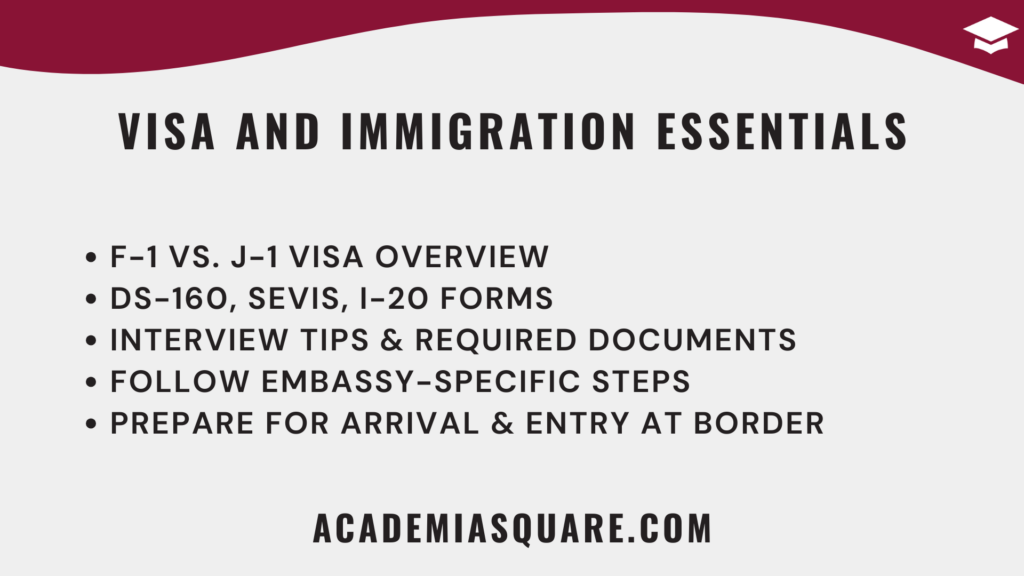
Once you receive your acceptance letter, your journey as an international student truly begins. Understanding the visa process is a vital step in how to apply to American university as an international student. Without the proper immigration documentation, even the strongest application won’t lead to a successful academic experience in the U.S.
This chapter walks you through the types of student visas, application procedures, interview preparation, and common pitfalls to avoid.
Types of Student Visas
The U.S. primarily offers two visa types for international students:
- F-1 Visa: The most common visa for students enrolled in full-time academic programs at universities, colleges, and language schools.
- J-1 Visa: For students participating in exchange programs or specific training. Often used for short-term academic experiences or government-funded programs.
In most cases, you’ll apply for an F-1 visa. The requirements and procedures are well-established but still require close attention to detail.
What You Need to Apply for a U.S. Student Visa
After accepting your admission offer and submitting your financial documentation, the university will send you an I-20 form (for F-1) or DS-2019 form (for J-1). You must have this before booking your visa interview.
The visa application process includes:
- Paying the SEVIS fee ($350 for F-1, $220 for J-1) at fmjfee.com.
- Filling out the DS-160 online application at ceac.state.gov.
- Booking a visa interview at the U.S. embassy or consulate in your country.
During the interview, be ready to explain why you chose your school, your study plans, and how you’ll fund your education. Carry physical copies of:
- Your I-20 or DS-2019
- Proof of payment for the SEVIS fee
- Admission letter from your university
- Passport valid for at least six months beyond your program start date
- Proof of financial ability (bank statements, scholarship letters, affidavits of support)
Tips to Succeed in Your Visa Interview
The visa interview is often the most stressful part of the process, but preparation makes a big difference. Here are practical tips:
- Be confident and honest: Officers are trained to spot inconsistencies. Stick to facts and avoid exaggeration.
- Practice answers: You’ll likely be asked about your academic goals, reasons for studying in the U.S., and post-graduation plans.
- Dress formally: Treat it like a professional job interview — first impressions matter.
If your visa is approved, the consular officer will keep your passport and return it with the visa stamped inside. Processing times vary by country, so apply as early as possible.
A visa doesn’t guarantee entry — the final decision is made by Customs and Border Protection (CBP) when you arrive. Make sure to carry your I-20, passport, and admission letter in your carry-on bag.
Understanding immigration rules is essential not only to start your studies but also to maintain legal status while in the U.S. — which we’ll discuss more in Chapter 12.
Financial Planning and Scholarships
Studying in the United States can be expensive, but it doesn’t have to be unaffordable. A smart financial strategy is key to how to apply to American university as an international student. This chapter explores tuition costs, funding options, budgeting tips, and how to find and apply for scholarships as an international applicant.
Understanding the Costs
On average, international students can expect the following annual costs (though this varies widely by institution and location):
- Tuition and fees: $15,000–$50,000+ depending on the university and program
- Living expenses: $10,000–$20,000 (includes housing, food, transport, books, insurance)
- Miscellaneous: Health insurance, visa costs, travel, and personal spending
Public universities often have lower tuition compared to private institutions, but may not always offer international scholarships. That’s why understanding your budget and finding financial aid early on is critical.
Types of Financial Aid for International Students
- Merit-based scholarships: Awarded based on academic achievements, test scores, or leadership qualities. Often renewable.
- Need-based aid: Some schools like Harvard and MIT offer need-aware admissions with generous aid packages.
- Departmental awards: Especially for graduate students, these include assistantships, fellowships, or research stipends.
- External scholarships: From organizations like Fulbright, DAAD, or local government programs.
Many universities list scholarship opportunities on their admissions or international office websites. Pay attention to application deadlines, which may be earlier than general admission dates.
How to Apply for Scholarships
Scholarship applications may require additional essays, interviews, or forms. Here are key strategies:
- Tailor your application to the scholarship’s mission or values.
- Highlight achievements that reflect leadership, resilience, or service.
- Ask your recommenders to write letters that align with scholarship criteria.
- Start your search early — at least 12 months before your planned enrollment date.
Websites like Fastweb, IEFA.org, and ScholarshipPortal can help you discover new opportunities, but always verify eligibility and deadlines directly.
Budgeting for Life in the U.S.
Even with scholarships, it’s essential to manage your money wisely. Here’s a basic checklist for international student budgeting:
- Open a U.S. bank account as soon as you arrive to avoid international transaction fees.
- Create a monthly budget that includes fixed and flexible costs.
- Use student discounts, campus facilities, and public transport to save money.
- Look for on-campus jobs (allowed under your F-1 visa) for extra income and experience.
Financial stress is one of the top reasons students underperform or drop out. A clear financial plan — combined with available resources — can reduce uncertainty and help you focus on what really matters: succeeding academically and enjoying your U.S. experience.
Post-Admission Steps
Congratulations — you’ve been accepted! But your journey isn’t over. A crucial part of how to apply to American university as an international student includes the steps you take after admission. This phase determines how smoothly your transition into U.S. academic life will be.
From securing housing and confirming enrollment to arranging travel and preparing for orientation, the actions you take in the weeks after admission can make or break your first semester. Here’s how to handle this important phase with confidence and efficiency.
Confirm Your Enrollment and Pay Deposits
Start by accepting your offer and paying the enrollment deposit — usually due within a few weeks of admission. This secures your seat in the program. Some universities may also require a housing deposit or immunization forms before allowing course registration.
- Check the I-20: Make sure your name, birthdate, and program details are correct before booking your visa interview.
- Email confirmation: Always save the official admission and deposit receipts for visa and travel documentation.
Secure Housing Options
Most universities offer both on-campus and off-campus housing. On-campus options are ideal for first-year international students because they provide a built-in community and easier access to services.
- Apply early: Housing is often limited and competitive.
- Check move-in dates: These may affect your travel plans and flight bookings.
- Review meal plans, rules, and amenities to choose the best living arrangement for your needs.
Register for Orientation and Classes
Orientation programs for international students are designed to help you acclimate to U.S. academic and social norms. These sessions typically include:
- Campus tours
- Visa compliance workshops
- Course registration help
- Health insurance enrollment
Also, use this time to meet with your academic advisor. They can guide you in selecting the right courses, planning your major, and tracking degree progress from day one.
Prepare for Travel and Arrival
Book your flights well in advance and plan to arrive before orientation begins. Keep essential documents like your passport, visa, I-20, and acceptance letter in your carry-on — they will be needed at U.S. customs.
- Pack essentials (adapters, medications, important documents).
- Coordinate airport pickup if your university offers it.
- Inform housing offices of your arrival time.
These tasks may seem overwhelming, but they’re manageable if handled systematically. Completing post-admission steps efficiently ensures that you enter your new academic environment ready to thrive.
Adapting to Life in the U.S.
Arriving in the United States marks the start of a new phase — one that requires cultural adjustment, academic adaptability, and personal growth. A major element in how to apply to American university as an international student is not just getting in, but thriving once you arrive.
This chapter is about the realities of being a student abroad. While exciting, the transition often includes homesickness, culture shock, and navigating unfamiliar systems. Here’s how to make that shift more manageable and enriching.
Dealing with Culture Shock
Cultural adjustment usually happens in four stages: honeymoon, frustration, adjustment, and acceptance. It’s normal to feel overwhelmed or isolated initially. Recognizing the pattern helps you cope better.
- Stay connected: Call family, but also push yourself to engage locally.
- Be patient: It takes time to adjust — don’t expect to feel at home immediately.
- Ask questions: Americans are generally open and willing to help if you ask.
Understanding Academic Expectations
The U.S. academic system may differ from your home country. Professors expect participation, critical thinking, and time management. Plagiarism policies are strictly enforced, and independent work is highly valued.
- Use campus resources like writing centers and tutoring labs.
- Join study groups to exchange perspectives and stay motivated.
- Use office hours — professors expect students to come with questions.
Building a Social Life and Support Network
Don’t isolate yourself. Get involved in campus organizations, clubs, or international student groups. Making friends — both international and American — will help you feel more connected and reduce stress.
- Attend events during international orientation week.
- Join cultural clubs or volunteer programs to meet like-minded peers.
- Find a mentor or buddy program — many schools offer them for first-year international students.
Remember: adapting takes time, but every challenge is an opportunity to learn. By embracing new experiences, you’ll develop the confidence and skills needed to thrive both in and outside the classroom.
Maintaining Visa Status and Planning for the Future
Learning how to apply to American university as an international student doesn’t end with getting in — it continues with staying in. To make the most of your U.S. education, you must maintain your F-1 or J-1 visa status throughout your program and understand your post-graduation options.
Staying Compliant with Visa Requirements
Maintaining status means following U.S. immigration laws while enrolled:
- Enroll full-time: You must complete the minimum required credit hours each semester (usually 12 credits for undergraduates).
- Update your SEVIS record: Report address changes, major changes, or travel plans to your Designated School Official (DSO).
- Don’t overstay your visa: Ensure your I-20 and visa are valid at all times.
Failing to comply can result in termination of your SEVIS record, which may jeopardize your ability to study, work, or re-enter the U.S.
Working Legally While Studying
International students on F-1 visas are allowed limited work:
- On-campus employment: Up to 20 hours/week during the semester. No special authorization needed.
- CPT (Curricular Practical Training): Allows off-campus internships related to your major, with approval from your DSO.
- OPT (Optional Practical Training): Post-graduation work authorization for up to 12 months (or 36 months for STEM graduates).
Plan ahead for OPT — you must apply early, and it can take months for USCIS to process your request.
Post-Graduation Pathways
Many international students want to stay in the U.S. after graduation for work or further study. Your options may include:
- Pursuing a Master’s or Ph.D. program
- Applying for an H-1B work visa (sponsorship required)
- Transitioning to a different visa category (e.g., O-1 for individuals with extraordinary ability)
- Exploring entrepreneurship options under new USCIS programs
Each path has strict requirements, so seek legal advice early. University international offices often provide free or low-cost legal consultations.
By staying informed, proactive, and compliant, you’ll not only protect your visa status but also create a future full of opportunity. Whether you return home or build a career in the U.S., your education will be a powerful springboard.
Sources and Recommended Reading
- SAGE Encyclopedia of Higher Education: Internationalization and International Students
- Explaining the College Choice Decisions of International Students at English-Speaking Universities
- EFITS International Student Guide – Visa Application Process
- How to Obtain Authentic International Academic Credentials
- OpenStax: Your Academic Journey and Personal Story
- OpenStax: College Readiness Checklist
- IIE Spring 2024 Snapshot on International Educational Exchange
- IIE Fall 2024 Snapshot on International Student Enrollment
- Academia Square: How to Choose a College Major
- Academia Square: How to Choose a University
- U.S. Department of State – EducationUSA: Your 5 Steps to U.S. Study
- U.S. Department of State – Student Visa (F & M)
- DHS Study in the States – International Student Guide
- U.S. Citizenship and Immigration Services – SEVIS I-901 Fee Payment
- U.S. Department of Education – College Navigator


